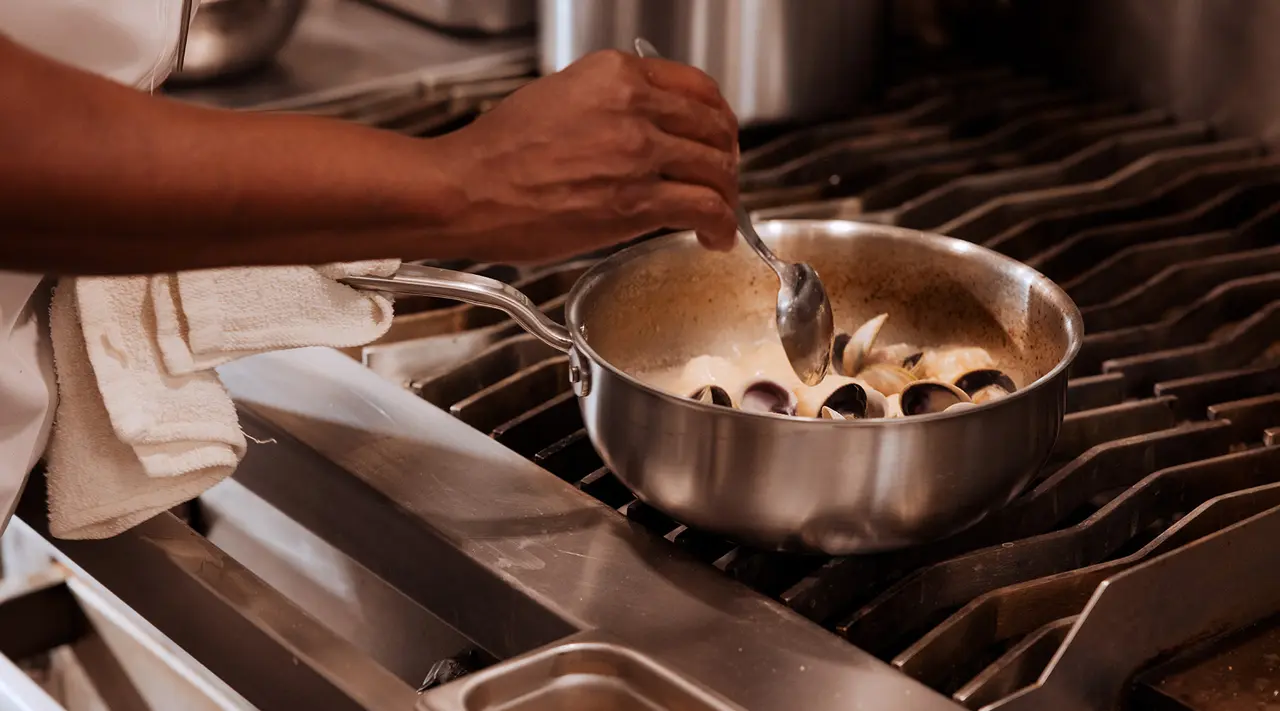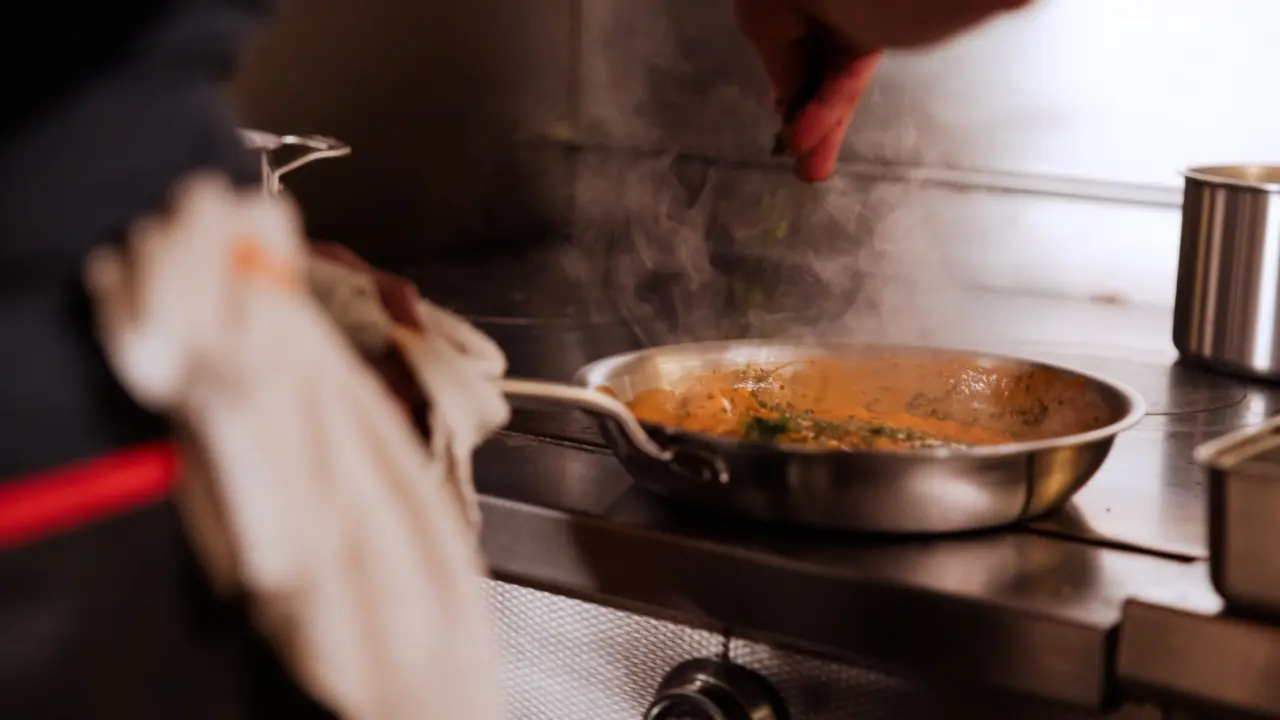Close your eyes and picture a restaurant kitchen in the quiet dawn hours, pots and pans gleaming, ready for a day of cooking. Those pots and pans are probably stainless steel—otherwise known as the most versatile cookware material around, and favorite of professional and home chefs alike.
But if you don’t know how to cook with stainless steel, preparing anything with this material can seem tricky and intimidating. Read on to learn some key skills to master cooking with stainless steel cookware.
Why Use Stainless Steel Cookware?
The question to be asked here isn't what to use stainless steel pans for—it's what can't it be used for. This material retains heat beautifully, keeping temperatures consistent when braising, searing, simmering, or sautéing. And if you’re making a sauce, stainless steel is capable of gently cooking aromatics and then quickly heating to a boil once liquid is added. Stainless steel is also oven safe up to 800F, making it easy to start a dish on the stove and transfer to the oven to finish.
Stainless steel is also the ideal choice when making pan sauces—not only can you use the crispy browned bits, aka fond, left behind after searing, sautéing, or roasting, but its nonreactive nature also means you can use acidic ingredients without introducing off flavors or stripping any seasoning.
How to Cook with Stainless Steel

By following a few key techniques, you can learn how to cook with stainless steel and avoid sticking or burning. The most important things to keep in mind are the two Ts: timing and temperature.
Check out the video up above or follow the steps below.
How to Keep Ingredients From Sticking to Stainless Steel
Perhaps the biggest misconception about stainless steel is that food sticks to it. Luckily, sticking is easily avoidable with the right technique. (And even if your food does stick, don’t sweat it: stainless steel is easy to clean up, and we’ll tell you exactly how to do it.)
1. Temper Your Food
Set yourself up for success and temper your ingredients—or bring them to room temperature (or close to it)—before they even reach the pan. Putting cold food into a hot pan increases the likelihood that your food will stick since it both lowers the overall temperature of the pan and causes the pores of the pan to expand and contract rapidly. Across the board, food cooks more evenly when it's at an even room temperature instead of varying degrees of cold.
Let proteins sit at room temperature for about 20 to 30 minutes, and vegetables for longer. The ingredient’s core temperature may not be exactly at room temperature, but that’s fine—as long as the surface isn’t straight-from-the-fridge-cold, you should avoid stickage.
2. Preheat Correctly
Once your food is tempered, preheat your empty pan for a few minutes before adding oil or cooking fat. To see if your pan is properly heated, splash a few drops of water onto the surface. If they bead up and dance around the surface, then your pan is preheated and ready to go. If nothing happens, it still needs time to preheat; and if the water sizzles immediately, turn the heat down a bit.
3. Use Enough Oil
Now, add your oil. If you’re going to cook over high heat, use oil with a high smoke point, such as grapeseed or sunflower. If you’re only cooking over medium heat, olive oil works too. Avoid cooking sprays, which can polymerize onto the pan’s surface and become difficult to remove.
How much oil you should use depends on what you’re cooking, but in general a thin coating will suffice—especially if you’re cooking something like skin-on chicken that will render out more fat as it cooks. To avoid sticking, let the oil heat up for a few minutes before adding your ingredient. You’ll know you’re ready to cook once the oil shimmers and ripples across the surface, but if the oil starts to smoke, then your pan is too hot.
4. Be Careful with Delicate Ingredients
If you’re cooking something more delicate, like fish or eggs, then adding a little more oil to the pan will help reduce sticking. But it really comes down to making sure your pan and oil are properly preheating, and letting your food cook long enough before stirring or flipping. Stainless steel makes for pretty informative cookware if you know what to look for—i.e., letting the food release from the surface when it's ready to be moved.
Skin-on Fish
For skin-on fish—which we recommend for the delightfully crispy fish skin you’ll achieve in stainless steel—lay the filet skin-side down, making sure it’s flat against the skillet’s surface. Let the fish cook until it easily releases when you slide a thin spatula underneath. If it’s not releasing easily, then that means it needs to cook longer. Once flipped, cook to your desired degree of doneness.
Eggs
For eggs on stainless steel, preheat your pan over medium-high heat, do the water test (see below), add your oil, then cook eggs in your preferred method, whether scrambled or fried. Do keep in mind that the eggs will cook quickly—for scrambled, we’re talking 1-2 minutes, tops—since you’re using medium-high heat. If you’re making fried eggs, reduce the heat to medium-low after adding the eggs, then cook until the whites and yolks are as set as you’d like. Know that if you cook over higher heat, you’ll get crispy whites with browned, lacy edges.
If you’re worried about cooking delicate ingredients on stainless steel, it’s perfectly fine to opt for a different cookware. Our Non Stick Collection and well-seasoned Carbon Steel offer reliable protection against sticking. And if you’re determined to use stainless steel, don’t give up if you don’t succeed the first time! If all else fails, you can clean your pan and try again. Once you nail it, you’ll proceed to impress anyone who’s around come meal time.
5. Fully Clean Your Pans
Any residue left behind in your pan will cause future food to stick, so help future you out and make sure your pans are fully cleaned after every use.
For everyday messes—such as grease and fond—warm water, soap, and a sponge work well. Once clean, rinse and dry your pan with a towel. Drying helps prevent water marks and potential calcium deposits, keeping your pans looking their best.
Though they seem impossible to clean, pans with burnt, blackened, or scorched bottoms are easily fixed with the oldest trick in the book: boiling water. Add enough water to cover the bottom of your pan, bring it to a boil, and gently scrape with a wooden spoon or other non-abrasive spatula until all of the scorched bits release. If you need extra help, use a 50/50 mix of water and white vinegar. Once clean, wash with soapy water, rinse, and dry.
Over time and with frequent use, your pan may discolor. Don’t fret—this is normal and easy to correct with our Stainless Steel Cleaner. Clean your pan with soapy water and a sponge, then sprinkle the pan with the cleaner and add enough water to make a paste. With a new sponge (or something bristly like an old toothbrush), rub the paste all over the pan, inside and out. Depending on the pan’s discoloration, this may take a few minutes. Once the pan is shining like new, rinse well and dry before storing.
For slightly tougher cleaning projects, see our guides for removing calcium deposits, removing heat tint, and cleaning burnt stainless steel.
Mistakes to Avoid When Cooking with Stainless

Cooking with stainless steel isn’t difficult, but there are a few common mistakes you should know about and learn to avoid. The good news is, once you master how to cook with stainless steel pans, there’s no going back.
1. Impatience
Patience is the biggest virtue when cooking with stainless steel. Whether it’s a Frying Pan for searing, Saucepan for sautéing, a Rondeau for deep frying, or Stock Pot for braising, preheating your pans is essential. Preheat your pan for a few minutes over medium-low heat before adding oil.
You’ll know the pan is hot enough if a small drop of water stays intact and rolls around on the surface before evaporating, also called “the water test”. When the pan is at the correct temperature, a thin layer of air forms between the water and pan, allowing the water to roll around like a marble. If the pan is too cold, it’ll evaporate quickly; if it’s too hot, the water will fracture and scatter.
Once you add your oil, wait another minute or two to let it heat until it shimmers, and then you can add your ingredients and adjust the heat as needed.
2. Not Washing by Hand
Just because you can do something doesn’t mean you should. Yes, stainless steel pots and pans are technically dishwasher-safe. But we don’t recommend putting our Stainless Clad Cookware in the dishwasher, since repeated exposure to a harsh dishwasher can degrade your pan’s quality over time.
Besides, large pots and pans take up space—it’s more efficient to wash the big stuff by hand and load up your dishwasher with smaller mugs, plates, and bowls instead.
3. Adding Salt to Cold Water
Salt is a powerful mineral, enhancing the flavor of any ingredient it touches. But salt is corrosive, too. If you use a Stainless Clad Stock Pot to make pasta, for example, then you probably know to add salt to the cooking water to make a super flavorful dish. Be sure to add the salt once the water is already hot, though.
Adding salt to cold water lets it settle to the bottom, and over time you may see pitting at the bottom of your pot. Stir salt into hot water and it’ll dissolve quickly, avoiding its potential damaging properties.
4. Overheating
Preheating your pan is always a good idea, but take care not to overheat. Since stainless steel conducts and retains heat so well, any food that comes into contact with an overheated pan is more likely to burn. Your pan may also discolor if overheated—if so, use diluted vinegar and a little elbow grease to buff the pan back to its shiny self.
5. Not Allowing Pans to Fully Cool
You know how for every action there’s an equal and opposite reaction? Same is true with heat and stainless steel. After you’re done cooking, let the pan cool to room temperature before cleaning, or you risk thermal shock warping your cookware.
Ready to Shop?
Stainless steel is a standby in professional and home kitchens for a reason. (Or several, as you’ve just read!) Whether you're sautéing vegetables, searing a steak, or simmering a stock, it's the right material for nearly any style of cooking. Now that you know how to cook with stainless steel cookware—and clean it to maintain its longevity—check out our full line of Stainless Clad Pots, Pans, and Cookware Sets to see the difference chef-loved cookware can make in your cooking routine.




























